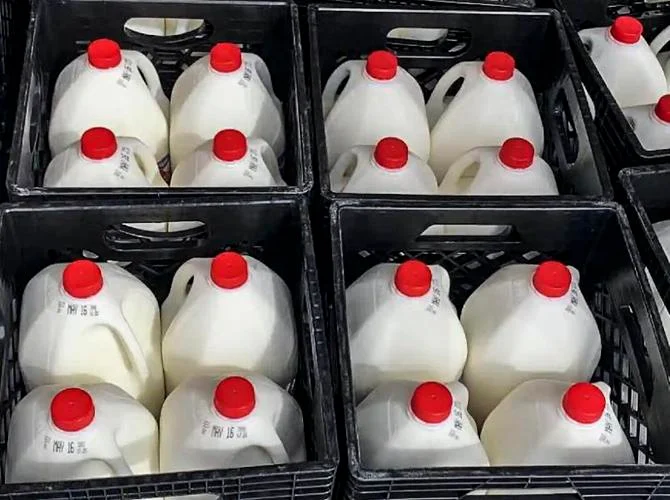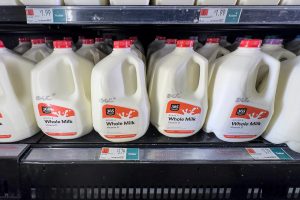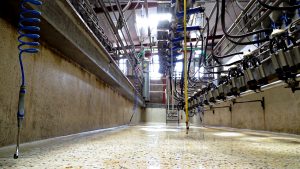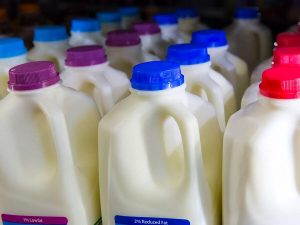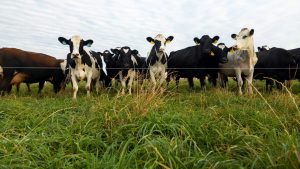
Discussions of Federal Milk Marketing Order modernization are well underway. Letters, policy proposals, webinars and petition notices have overloaded the inboxes of dairy farmers and others in the industry for some time. The task of weeding through those communications in order to understand how the pieces fit together, what happens next and what it means for farmers is an arduous one. In this Market Intel we attempt to break down recent happenings in milk-pricing policy and provide an update on American Farm Bureau Federation priorities.
The Federal Milk Marketing Order system has been a pillar of the dairy industry for more than 80 years. There have been few major changes to milk pricing and the administrative process in more than a decade, apart from the infamous change to “higher-of” pricing of Class I milk in the 2018 farm bill.
Milk-pricing regulations in place today were mostly set during an overhaul of federal milk orders in 2000. That overhaul introduced end-product pricing formulas, by which regulated milk handlers are required to pay farmers based on the milk handlers’ utilization of milk. Currently the 11 regional marketing orders across the country follow a nationally set base framework of regulations and requirements. Beyond this national framework, many region-specific provisions exist, including those related to regional pooling and the use of transportation credits. This article focuses on Federal Milk Marketing Order amendment efforts that would apply to all 11 federal orders at the national level.
Starting point
Many in the industry credit the Feb. 14, 2022, release of University of Wisconsin’s Mark Stephenson’s “Cost of Processing Study for Cheese, Whey, Butter and Nonfat Dry Milk Plants” as the kickoff for recent actions on federal-order modification. The study was commissioned by the U.S. Department of Agriculture through the University of Wisconsin to review and update the costs of production for dairy-processing plants. It provides new weighted average costs of processing-plant production for the various types of Cheddar cheese, butter, whey and nonfat dry milk. Such cost data has been used as a basis for evaluating and adjusting make allowances during a Federal Milk Marketing Order amendment process.
As a refresher, end-product pricing formulas in the federal-order system include a fixed deduction from each product price called a make allowance, i.e., a processing credit, as well as yield factors for turning raw-milk components into finished dairy commodities. In general, any increase in make allowances increases the deduction to cover processors’ cost, decreasing dairy farmers’ take-home pay in the short run. A decrease in make allowances would have the opposite effect on dairy farmers’ pay. Make allowances are based on an estimate of the costs associated with converting a hundredweight of raw milk into commodity dairy products, including butter, cheese or dry milk powder. They are intended to be large enough to encourage the construction and maintenance of processing capacity. They include plant costs directly associated with processing such as labor, utilities, non-dairy ingredients like salt and cultures, testing and packaging. They do not include the cost of marketing, storage or other pre- or post-processing expenses.
The current high-cost environment for producers and processors has driven two prominent dairy-processing organizations to seek increased make allowances to help offset increased expenses. Providing a numeric basis for these requests, the Stephenson study showed all commodities except butter had bigger cost values ranging from 5 cents to 13 cents more per pound than current make allowances. Combining data from the USDA’s Agricultural Marketing Service on total class utilization volumes with the classified value make allowances indicate total make allowances – based on 3.5 percent butterfat content – would have increased almost 33 percent under these updated cost-study values in 2021. This equates to a single-year $1.45 billion Federal Milk Marketing Order-wide increase in milk-formula deductions to cover estimated increases in processor costs. It would have reduced the regulated revenue dairy producers would have received by the same magnitude, all else held equal.
Petitions submitted, objections made
The first step of the Federal Milk Marketing Order-amendment process requires an interested party such as a farmer or milk handler to submit a formal proposal to the USDA, requesting the establishment of a new federal order or the amendment of one or more provisions of an existing one. Both the International Dairy Foods Association and the Wisconsin Cheesemakers Association submitted petitions March 28 for a federal-order hearing to increase make allowances. Days later the National Milk Producers Federation, Edge Dairy Cooperative and the American Farm Bureau Federation all wrote letters objecting to the proposals submitted by the International Dairy Foods Association and the Wisconsin Cheesemakers Association.
After the Federal Milk Marketing Order Petitions were submitted, the USDA had 30 days to issue an action plan to complete a hearing within 120 days, request additional information from the International Dairy Foods Association and the Wisconsin Cheesemakers Association, or reject their requests. A hearing, which includes relevant witness testimony, is the formal administrative process the USDA uses to collect information, data and analysis to issue a recommended decision and final decision, which producers vote on through a referendum. If the decision of the Federal Milk Marketing Order hearing passes the referendum of producers, by two-thirds of total number of producers or two-thirds of producers by volume of milk represented, the changes and their effective date are published in the Federal Register. If the decision of the Federal Milk Marketing Order hearing isn’t approved, the USDA generally terminates the order(s) altogether. Currently cooperative handlers are considered, in some ways, as the “producers” within a referendum process. This means cooperatives can and usually do choose to vote for their entire membership in a practice known as bloc voting, which precludes individual member producers from voting on their own.
Mandatory cost, yield surveying
There are a wide range of objections to the International Dairy Foods Association and the Wisconsin Cheesemakers Association petitions. While many thousands of pages can be written about these topics, we attempt here to simplify for brevity. As mentioned previously, there is first and foremost concern about increasing make allowances and the potential impact any revisions could have on farmers’ milk checks. Neither the International Dairy Foods Association nor the Wisconsin Cheesemakers Association presents specific desired make allowance numbers in their petition. Instead they reference the use of past studies such as the 2021 Stephenson study and ongoing studies that can be used to inform future make-allowance increases.
Notably the surveys they suggest using are voluntary, meaning manufacturing plants choose whether or not they would like to participate. Some may not choose to participate because of time and labor requirements to collect the necessary data or concerns about providing sensitive business information to researchers. Others may gauge how their participation may change the price formulas and affect their own bottom lines. For instance large, efficient processors could decline to participate, skewing cost data and increasing the deduction to cover processors’ cost in the milk-price formula – which would skew dairy farmers’ milk checks downward.
To measure the extent to which manufacturing plants choose not to participate we utilized participation data from the 2021 Stephenson study. That study targeted plants that made products qualifying under the USDA’s National Dairy Products Sales Report, which collects and releases dairy-product sales information for butter, Cheddar cheese, dry whey and nonfat-dry milk no later than 2 p.m. every Wednesday. A total of 153 plants across the United States are surveyed by the report. This number can be increased to 168 “plants” manufacturing different products because some locations produce more than one product.
Figure 1 displays the number and percentage of plants that participated in the 2021 study by product type. Eighty percent of butter plants, 76 percent of Cheddar cheese plants, 71 percent of dry-whey plants, and 40 percent of nonfat-dry-milk plants did not participate – which corresponded to 111 out of the 168 total plants not providing cost data.
Two-thirds of dairy-manufacturing plants did not participate in a survey that will potentially be used to inform binding minimum-pricing requirements for farmers. It was also noted that the data in these surveys was not audited, meaning the numbers that were submitted could be inaccurate. Clearly this gap in participation spurs concern amongst farmers who could have their checks decreased for years to come. Many organizations – including the American Farm Bureau Federation, the National Milk Producers Federation, the International Dairy Foods Association and the Wisconsin Cheesemakers Association – support the authorization of mandatory, audited surveying of cost and yield data from manufacturers. Similar to the National Dairy Products Sales Report, a cost survey would require the USDA to collect and release cost and yield data for dairy products relevant in the formulation of make allowances.
Such a survey may require Congress to direct the USDA to conduct it. The American Farm Bureau Federation, the National Milk Producers Federation, the International Dairy Foods Association and the Wisconsin Cheesemakers Association support such a survey but they disagree on timing of a change in make allowances. The American Farm Bureau Federation does not support make-allowance updates until a mandatory survey has been required by Congress. The National Milk Producers Federation is expected to support a modest increase in make allowances in the interim, and the International Dairy Foods Association and the Wisconsin Cheesemakers Association support larger increases observed in the referenced voluntary surveys.
To jumpstart the process of authorizing mandatory cost and yield surveying of processors, the American Farm Bureau Federation has worked with congressional offices from both parties seeking to add language to the Dairy Pricing Opportunity Act, which was reintroduced on March 23 by Rep. Langworthy, R-New York, and Rep. Morelle, D-New York. The bill would mandate cost and yield surveying of processors required to participate in the National Dairy Products Sales Report survey every two years.
Class I formula switchback
The Class I mover issue has been front and center in Federal Milk Marketing Order-modernization discussions. Prior to 2019, the formula to calculate base Class I skim milk was the higher of advanced Class III – cheese – and Class IV – butter and powders – skim-milk prices. The 2018 farm bill included a small provision that swapped the “higher-of” formula for the simple average-of advanced Class III and IV skim-milk prices plus 74 cents. The change was made at the request of the International Dairy Foods Association and the National Milk Producers Federation. It was intended as a revenue-neutral way to improve risk-management opportunities for beverage milk.
Disruptive market conditions induced by the COVID-19 pandemic quickly revealed a lackluster performance from the new formula. Significant spreads between Class III and Class IV prices, paired with the delay associated with advanced pricing, resulted in more money being paid out in Class III component values than what was collected from plants across all classes of milk. This, combined with the tactic of de-pooling used by many manufacturing plants to capture increased market prices, led to vast imbalances in pool value reflected on farmer checks as negative producer-price differentials. In 2020 alone, more than $700 million was lost in the revenue pool – partly due to the formula switch decreasing the payments many farmers received and resulting de-pooling. At first this imbalance was linked to COVID-19 forces. But the losses in pool value have continued through early 2023, as Class IV prices have become the driver of the dairy market. As displayed in Figure 2, cumulative pool losses have reached almost $920 million since the formula went into effect in May 2019, a clear reason why many organizations support a swift return to the higher-of formula.
Farmer organizations, including the American Farm Bureau Federation, have voiced significant concerns concerning initiating a federal-order hearing limited solely to make allowances. Other class formula-related adjustments – such as the Class I mover switch back to the “higher-of,” as well as the use of updated processing yields and Class I differentials – would help offset negative impacts of changes that could lead to reduced checks for farmers. The American Farm Bureau Federation supports going back to the “higher-of” as quickly as possible, meaning through a federal-order hearing or through legislation. Because it’s difficult to know whether the legislative approach or Federal Milk Marketing Order-hearing approach will be faster, efforts to pursue both are underway. The Dairy Pricing Opportunity Act mentioned previously combines cost-survey authorization with initiation of a Federal Milk Marketing Order hearing that explicitly addresses Class I issues including a switch to the higher-of. Standalone legislation on a switch back and-or inclusion in the upcoming farm bill are also under consideration.
The Class I mover topic is one of many class price adjustments producer groups are looking to have updated. Class I location differentials, fixed values ranging from $1.60 per hundredweight to $6 per hundredweight, are a vital element of the Class I beverage milk- price formula. Every U.S. county is assigned a Class I location differential based on the supply and demand characteristics of the region. To support production and marketing in milk-deficit regions, location differentials are added to the base value of Class I milk to determine the total class value. The current Class I differentials were established in 1998 with only a minor update in 2008. Many of the factors used to estimate differentials effectively have since changed, to the point that current differentials no longer ensure an adequate supply of milk to many plants. This results in disorderly marketing of milk, a condition the Federal Milk Marketing Order system is fundamentally meant to prevent. Farmer groups hope to include systematic updates to differentials in any future Federal Milk Marketing Order-hearing process.
Many other class formula priorities are expected to be incorporated into future proposals for broader Federal Milk Marketing Order revisions. Updating component factors for nonfat solids, protein and other solids used to calculate the Class III and Class IV skim-price formulas, expanding the number of products included in the National Dairy Products Sales Report survey, discontinuation of barrel cheese in the protein-component price formula and termination of advanced pricing are additional adjustments being considered by the industry.
Farmer voice maintained
An amendment to an order is determined by a referendum of producers. The voting-based system is intended to give farmers a direct role in deciding how they are regulated. Under the Agricultural Marketing Agreement Act, cooperatives are able to vote on behalf of their entire membership in what is known as bloc voting. This means that most dairy farmers who are members of cooperatives do not have the opportunity to cast individual and confidential ballots when it comes to voting on changes to Federal Milk Marketing Order milk-pricing rules, which could be regional or national in scope and would likely impact all members of the dairy industry – from the processor down to the farmer.
The American Farm Bureau Federation has prioritized an amendment to bloc voting that would require cooperatives to give notice to members of their intended vote during a federal-order hearing and give the members the right to opt out of that vote – to vote independently and confidentially. Within this process cooperatives must inform the producer of procedures to cast an individual ballot. This alternative form of voting is called modified bloc voting and would require a legislative change through Congress. Figure 3 demonstrates how traditional bloc voting and modified bloc voting work.
Simply providing individual dairy farmers the opportunity to opt out of a bloc vote and vote the way they desire not only provides individuals with more say in their future but also strengthens trust between producers and their processors, which has been strained for some. The success of a modified form of bloc voting within the Dairy Checkoff confirms viability and ease of integration in the current framework. Modified bloc voting would result in other benefits for cooperatives and their members. Putting more weight on the individual voices of farmers forces stakeholder interaction and education on the wide and often complex range of issues being considered. The American Farm Bureau Federation hopes to include modified bloc voting provisions in the language of the upcoming farm bill.
The American Farm Bureau Federation also seeks to modify other features of the voting procedures used when amending Federal Milk Marketing Orders. To modify a Federal Milk Marketing Order, at least a two-thirds majority of the eligible producers voting in the referendum, or the eligible producers who supply more than two-thirds of the milk represented in the referendum, must vote in favor of the order as amended. This arrangement lessens the voice of smaller producers who can be easily overridden when more than two-thirds of the milk volume represented becomes the deciding factor. The American Farm Bureau Federation supports changing the procedure to at least a two-thirds majority of the eligible producers voting in the referendum and the eligible producers who supply more than two-thirds of the milk represented in the referendum voting in favor of the order as amended. This balances the voice of both small and large producers, incentivizing preservation of a system that works for all regardless of operation type.
Historically the USDA has terminated an order(s) when a Federal Milk Marketing Order referendum fails. While there are situations when the un-amended continuation of an existing order would be inconsistent with a nationally coordinated system of federal orders, most producers would prefer to keep the existing order in place rather than face complete dissolution. Amendments are often offered to improve an order in one manner or another, not to signify complete dissatisfaction with their existence. Removing the threat of termination, where reasonable, allows farmers and other dairy stakeholders to more seriously consider updates and alterations to orders that they may otherwise be too nervous to attempt to change. The American Farm Bureau Federation supports eliminating any provisions that cause elimination of an order after a “no” vote occurs, unless there is adequate basis for such a result.
Transparent milk checks
In order to modernize the federal-order system successfully, prioritizing adjustments that help build trust between dairy farmers and dairy product manufacturers is key. In recent memory, trust between some producers and the buyers of their milk has been strained, often amplified by management decisions that may seem misleading. One such example is the manner in which farmers are shown how they are paid. Each handler, whether cooperative or proprietary, presents farmer-milk-check calculation differently. In many cases the values farmers see for their milk components – butterfat, protein and other solids, producer price differentials, assortment of possible premiums, transportation deductions and any other market adjustment are very difficult to compare. Farmers within the same county have reported completely opposite producer-price-differential values, wide-ranging and undefined market adjustments, or vastly different component values. These values are often displayed without additional context, leaving many farmers confused how each line item is calculated and skeptical of their handlers’ accounting practices. The belief that these values are being reported in a confusing way to purposely hide the real bottom line is widespread, leading to unhelpful tension between farmer and handler. The American Farm Bureau Federation supports a more-transparent and consistent format for handlers to use on milk checks to producers that clearly presents where each number comes from. Transparency should build trust and help make the federal order system more resilient.
Conclusion
The dairy industry agrees Federal Milk Marketing Orders are far overdue for updates to ensure the system works as intended within the current marketplace. Recent petitions formally made by processor groups to update one piece of the system require the USDA to carefully decide whether or not those requests have a strong-enough basis to initiate a hearing process. In the meantime other dairy organizations may submit additional proposals to highlight their own priorities or express opposition to the existing petitions. The American Farm Bureau Federation seeks legislative authorization of mandatory cost and yield surveying followed by a more-comprehensive package to broadly update a number of class-formula-related adjustments to ensure confidence and fairness in how farmer checks are formulated. The American Farm Bureau Federation also has a number of referendum-process-related priorities, including a switch to modified bloc voting, to maintain and expand the voice of dairy farmers within a system that dictates the revenue those families take home each and every day. It is vital that farmers keep informed and abreast of these policy developments, which can significantly impact the industry’s future.
Visit www.fb.org/market-intel for more information.

